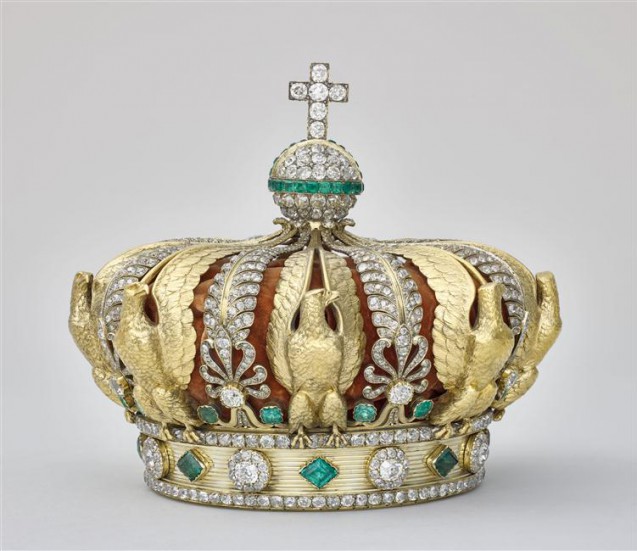The ‘Diamonds of the Crown of France’, an inalienable treasure embodying the power of the monarchy, survived throughout French history from the creation of the institution in 1530 by François I up to the Second Empire. And Napoleon III was to make his own use of this fabulous treasure, just as all French monarchs had done before him. Whilst on the one hand he asked a group of jewellers to create new tiaras for the Empress using the jewels which they had in their shops, it was to Alexandre-Gabriel Lemonnier (c.1818-1884) that he turned with his commissions for the two imperial crowns using the stone from the ‘Diamonds of the Crown of France’. Lemonnier was to make his first crown in 1853, using the jewels from the crown of Charles X (seen on the official portraits of the Emperor and Empress by Winterhalter). This however was to be replaced in 1855 by a second, simpler crown. The Empress’s crown was modeled on that for the Emperor, although it was smaller and lighter. It is composed of bands formed by the wings of eight chased golden eagles alternating with eight palmettes extended by means of a large palm, and it is covered with 102 brilliant cut diamonds taken from the ‘Diamonds of the Crown of France’. To this were added 1,252 brilliant cut diamonds and 56 emeralds paid for by the imperial budget. On delivery of the crown in August 1855, Lemonnier was awarded a silver medal at the Exposition universelle for his «imperial crowns simple and tasteful, excellent in design, and expertly made».
In August 1870, the ‘Diamonds of the Crown of France’ were taken to Brest where they were to remain (after the fall of the regime) until 1872 when they were taken to the vaults of the Finance Ministry. They were then presented at the Exposition universelle of 1878 before being shown for the last time in 1884 at the Louvre. On 11 January, 1887, a law of disposal was passed concerning the ‘Diamonds of the Crown of France’, and the stone were put up for sale four months later. Fortunately the most prestigious pieces were not included in the sale, but many masterpieces and historic stones were to disappear into private hands, including notably the crown of Napoleon III. Eugénie’s crown did not suffer the same fate. It was returned to the fallen empress by the Third Republic after 1875 and subsequently bequeathed to Princesse Marie-Clotilde Napoléon. Put up for auction in 1988, the crown was offered by benefactors, Mr and Mrs Roberto Polo, to the Musée du Louvre where it joined the other jewels of France’s royal past.
Karine Huguenaud (tr. P.H.)
March 2007


